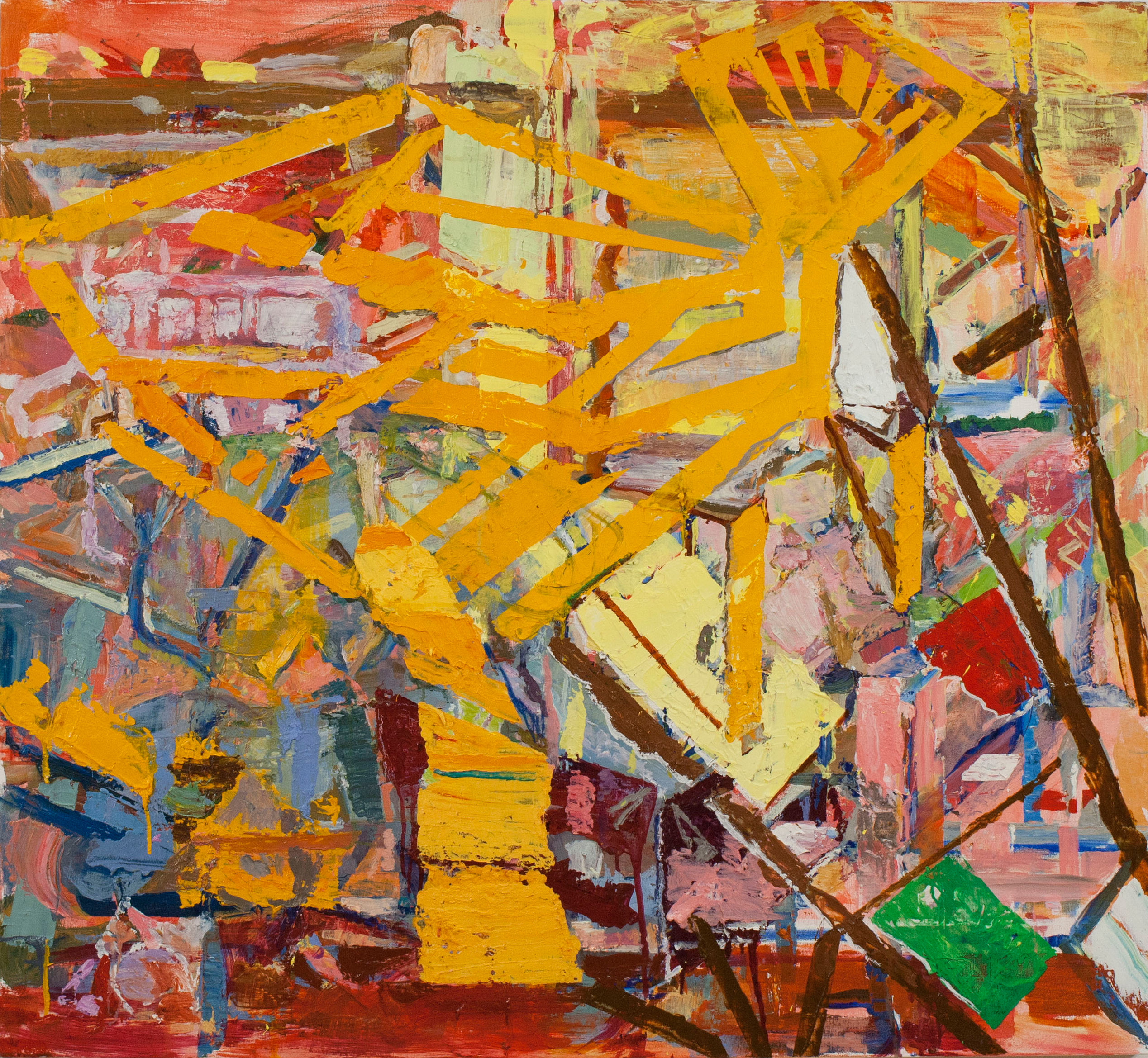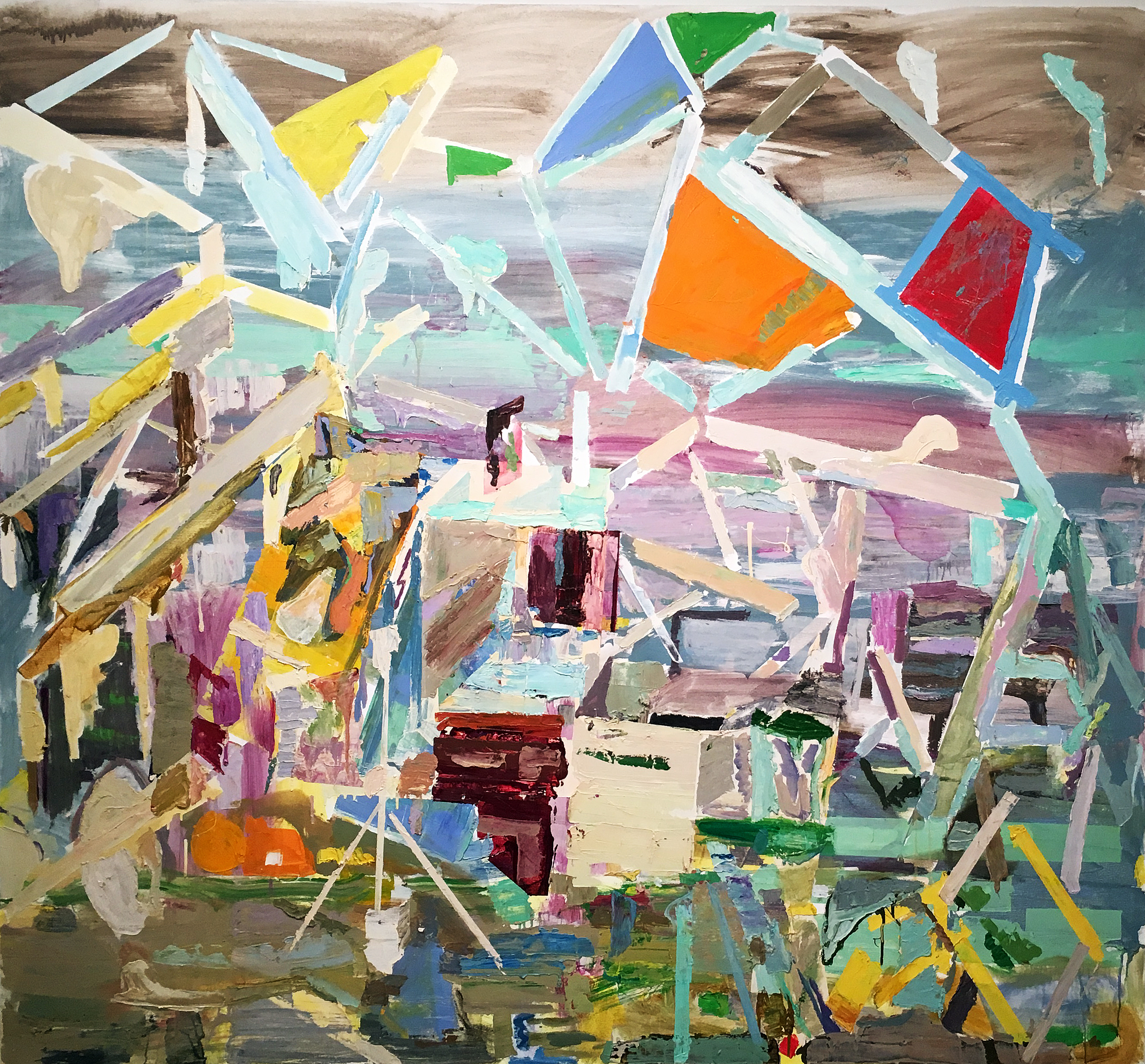
Thomas Berding, Command Tree, 44 X 48″, Oil on Canvas, 2013, Courtesy of Eli and Edythe Broad Art Museum Collection
Oakland University Art Gallery opened an exhibition, The Berding Memorandum, on September 15, 2016, with a collection of abstract expressionist work by Thomas Berdling, Professor of Studio Art at Michigan State University. His abstract expressionism has obliviously evolved over several years where earlier work has more reference to the real world, be it landscape or figures. While his work is not a literal translation, there is no mistake the paintings are a response to a particular situation, often referenced in work’s title. An example is the painting Command Tree, 2013, where you find a reference to an orange-yellow tree that comes forward dominating the composition over a re-shuffled landscape with background structures.
He says in an interview with Dick Goody, Director of the Oakland University Art Gallery, “While my paintings are not literal translations of the reference material I use, the paintings of the last five years have indeed been made in response to sources like the ones you intuitively feel are in the work. This includes the screen-based and two-dimensional schematic constructions that visualize this making and unmaking of the world, such as explosion views common in assembly manuals, flow charts, diagrammatic schemes, encrypted texts, among others.”

Thomas Berding, Breakage, Oil on Canvas, 70 X 76″, 2014 All Images Courtesy of Oakland University Art Gallery
Abstract Expressionism, born in the mid-1940s and lead the way for ten years as part of the New York City art scene, made a deep and lasting impression on artist Berding’s age group. It’s not hard to see the remnants of early Pollack, de Kooning, and color similarities with Matisse in Berding’s work. In the work Breakage, we experience a landscape that has a busy foreground, making way to a mid-ground of larger shapes, and upward to a sky with transparent building like shapes. His tools are less brush, and more palette knife and tape removed. Through out his work there is a unified effort to create a color feel, often a thematic color arrangement for a particular painting where a sense of mapping, charting or sorting is taking place.
Many historians feel the AE period was cut short as society sped towards change that was mirrored in daily life of the 1960’s and embraced Pop Art, Minimalism, and later conceptual art that thrived on installation. Looking back over the millennium, movements in art typically lasted longer, and this could be why artists of a certain age still want to explore the qualities they relate to in abstract work as if to say, the period wasn’t yet finished.

Thomas Berding, By Land and By Sea, Oil on Canvas, 70 X 76, 2008
With a palette dominated by green in Land and Sky, this abstraction seems to have an elevated point of view, as if the viewer is located high across the river overlooking the cityscape that leads to a horizon of buildings. The converging yellow shapes create an unreal type of perspective that takes the eye back towards the mid ground of complex color and shape. Richard Diebenkorn started out as a realistic artist, and gradually became an abstract painter that used the landscape in the 1950’s to create his Ocean Park series that depended deeply on his dependence with the local landscape. Here too, Berding give us his distinctively intense yet aloof rendition of his landscape experience, producing an ambiguous degree of abstraction that makes us wonder where he is going with this personal pandemonium?

Thomas Berding, Turning Tables, Oil, Acrylic, Flashe on Canvas, 24 X 24, 2016
In a gallery full of smaller square 24 X 24” work, we experience a work process that some would describe as studies. Here in Turning Tables, Berding gives us a painting that shares a sensibility with Matisse, both in using shape and color. Because smaller work can move along faster, it might be that the artist is using this process to become more spontaneous and intuitive with his internal tools. It’s as if he has said to himself; I need to loosen up and work a bit faster, at least conceptually and see where it goes?
Thomas Berding, born in Cincinnati, Ohio and received his MFA from the Rhode Island School of Design, has been recognized with awards from the National Endowment for the Arts, Pollack-Krasner Foundation, and over his career has exhibited in many venues through out the mid-west. He has obviously been educated and influenced by modernism with its reductive style, drawn to abstraction, resulting in a personal narrative that expresses a kind of controlled explosion of color and shape. For those living in the Metro Detroit area, the OUAG provides their students, and us with a fresh experience in the abstract expressionistic work of Thomas Berding.
Oakland University Art Gallery
